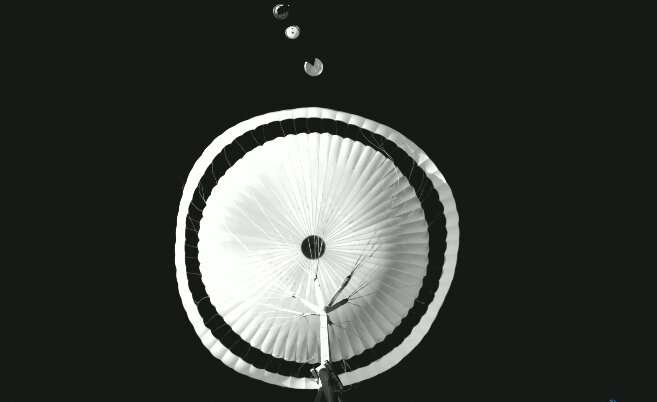First high-altitude drop test success for ExoMars parachute

After several weeks of bad weather and strong winds, the latest pair of high-altitude drop tests of the ExoMars parachutes took place in Kiruna, Sweden. The 15 m-wide first stage main parachute performed flawlessly at supersonic speeds, while the 35 m-wide second stage parachute experienced one minor damage, but decelerated the mock-up of the landing platform as expected.
The ESA-Roscosmos ExoMars mission, with the Rosalind Franklin rover and Kazachok surface platform, is scheduled for launch in September 2022. After a nine-month interplanetary cruise, a descent module containing the rover and platform will be released into the martian atmosphere at a speed of 21 000 km per hour.
Slowing down requires a thermal shield, two main parachutes—each with its own pilot chute for extraction—and a retro rocket propulsion system triggered 20 seconds before touchdown. The 15m-wide first stage main parachute opens while the descent module is still travelling at supersonic speeds, and the 35 m-wide second stage main parachute is deployed at subsonic speeds.
Adjusting and testing the ExoMars parachutes has been a priority following a series of unsuccessful drop tests in 2019 and 2020. The team improved the design by running ground-based, fast turnaround dynamic extraction tests at NASA’s Jet Propulsion Laboratory in California last year. And to mitigate risks before running these high-altitude drop tests, ESA ordered backup parachutes from the US manufacturer Airborne Systems, the very company that delivered Perseverance’s parachute system
Slow motion footage of ExoMars parachute during a high-altitude drop test. The video shows the 15 m-wide first stage main parachute being deployed flawlessly at supersonic speeds during a drop test on 24 June at the Swedish Space Corporation Esrange facility. Credit: European Space Agency
The most recent drop tests took place on 24 and 25 June at the Swedish Space Corporation Esrange facility. Each high altitude drop test saw a dummy descent module lofted to an altitude of 29 km by a stratospheric balloon inflated with helium. Following release, the pilot chute extraction is initiated with a controlled extraction of the main parachutes from their doughnut bags.
The first test focused on validating the Airborne Systems backup supersonic parachute—the first drop test for this parachute in this ExoMars test campaign. The second test was carried out the following night using the modified subsonic parachute and bag delivered by the Italian company Arescosmo. Each test was designed to apply the full load expected during the Mars entry, descent and landing, all with additional safety margins.
“We’re very happy to report that the first main parachute performed perfectly: we have a supersonic parachute design that can fly to Mars,” says Thierry Blancquaert, ExoMars programme team leader, noting that “there will be at least two further opportunities to test this parachute design to gain further confidence”.
“The performance of the second main parachute was not perfect but much improved thanks to the adjustments made to the bag and canopy. After a smooth extraction from the bag, we experienced an unexpected detachment of the pilot chute during final inflation. This likely means that the main parachute canopy suffered extra pressure in certain parts. This created a tear that was contained by a Kevlar reinforcement ring. Despite that, it fulfilled its expected deceleration and the descent module was recovered in good state.”
The team will be looking in more detail into the origin of this new anomaly before finalising the configuration of the next pair of drop tests foreseen to take place in October/November 2021 from Oregon, U.S.. Earlier issues due to the friction between canopy and bag now seem to be resolved.
Any adjustments made to the parachute system will first be tested on the dynamic extraction test rig at NASA/JPL to check how the release of the bag occurs, as it would happen in the martian atmosphere. These tests can be repeated on a quick turnaround and reduce the risk of anomalies.
High-altitude drop tests require complex logistics and strict weather conditions, making them difficult to schedule, and are often aborted at the last moment if the situation changes. The wind speed and direction at various altitudes has to be considered for a smooth ascent of the balloon and the on-ground recovery of the hardware given that the drop zone can only be accessed via helicopter.
The system under test is designed to deliver some telemetry in real time to a ground control centre to evaluate the deceleration profile. However, the true outcome of the test requires recovering the parachutes, bags, hard disks and high-resolution cameras.
ExoMars parachute successful recovery. Credit: European Space Agency
“We were in the starting blocks twenty-four hours a day, seven days a week, waiting for a suitable test window to open for a month,” adds Thierry. “We’re relieved to have finally conducted these tests and extend our thanks to all of the ground teams who worked so hard amid the added COVID-related constraints to carry out the tests, as well as retrieve and inspect the parachutes.”
The analysis of the telemetry data will help correlate the main parachutes deployment and the inflation models. The team will now work to understand the second pilot chute detachment, and to propose measures that can resolve this problem before the next high-altitude drop tests.



 Creators of mankind
Creators of mankind Description of “Tall white aliens”
Description of “Tall white aliens” Where they came from?
Where they came from? About hostile civilizations
About hostile civilizations The war for the Earth
The war for the Earth “Tall white aliens” about eternal life
“Tall white aliens” about eternal life Video: “Nordic aliens”
Video: “Nordic aliens” Aliens
Aliens Alien encounters
Alien encounters The aliens base
The aliens base UFO
UFO Technology UFO
Technology UFO Underground civilization
Underground civilization Ancient alien artifacts
Ancient alien artifacts Military and UFO
Military and UFO Mysteries and hypotheses
Mysteries and hypotheses Scientific facts
Scientific facts


















